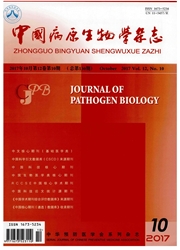

 中文摘要:
中文摘要:
目的调查云南省景东县流行性乙型脑炎的流行现状。方法媒介蚊虫凋查采用诱蚊灯通宵捕蚊方法.蚊虫乙脑病毒检测采取RT—PCR方法,健康人群血清乙脑病毒抗体检测采用ELISA。结果共采集到蚊虫4属15种6653只,其中三带喙库蚊和中华按蚊属于当地的优势种群,分别占总捕获蚊数的82.07%和10.46%。RT—PCR检测三带喙库蚊和中华按蚊共16批1310只,各有l株感染乙脑病毒;E1。ISA检测当地健康人群血清乙脑病毒抗体阳性率为72.96%.不同年龄组人群乙脑病毒抗体水平差异有统计学意义(χ^2=51.589,P〈0.01)。结论云南景东县蚊虫种类较多,三带喙库蚊和中华按蚊有传播乙型脑炎的作用。
 英文摘要:
英文摘要:
Objective To explore the prevalence of Japanese encephalitis (JE) in Jingdong County, Yunnan Province. Methods Mosquito lamp traps were used to capture mosquitoes overnight. RT-PCR was used to detect the virus in mosquitoes infected with the Japanese encephalitis virus (JEV). and enzyme linked immunosorbent assay (ELISA) was used to detect JEV antibodies in healthy residents. Results A total of 6 653 individual mosquitoes from 15 species in 4 gene ra were collected. Of these mosquito species, Culex tritaeniorhynchus and Anopheles sinensis were the local dominant species, and they accounted for 82.07% and 10.46% of the total mosquitoes collected. RT PCRdetected aJEV strain in both Cx. tritaeniorhynchus and An. sinensis in 16 batches of 1 310 individual mosquitoes. ELISA detected JEV antibodies at a rate of 72.96% from the sera of healthy residents, and there was a significant difference between age groups (χ^2 =51. 589,P〈0.01). Conclusion There are a relatively large number of vectors of Japanese encephalitis in Jingdong County, and Cx. tritaeniorhynchus and An. sinensis play an important roles in local JE transmission.
 同期刊论文项目
同期刊论文项目
 同项目期刊论文
同项目期刊论文
 期刊信息
期刊信息
